Human Interest
Silk Road notes 2: trade
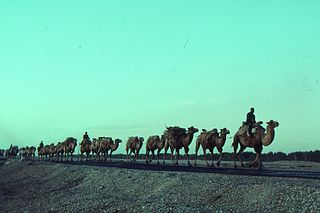
This article continues the series about the Silk Road exhibit at the Cleveland Museum of Natural History. As mentioned, the Silk Road exhibit betrays its name and deceives the visitors, individuals, schoolteachers and students who come to view it. Some of the visitors are of those cultures who made formidable contributions. Yet this exhibit omits or gives scant recognition to these contributions. This denies some viewers the knowledge and sense of pride they might otherwise have, if they could learn their heritage contributed to the growth of civilization along the early trade routes. For instance, this Islamic presentation allowed about 20% credit to the Chinese, where the Silk Road began.
To see Part 1, follow this link.
Trading along the route of the Silk Road
EXHIBIT SIGN:
Precious Wares
The Sogdian Culture of Samarkand was closely linked with the Persian realm – through language, religion and the arts. Both Persian and Sogdian artists excelled at the craft of shaping beautiful objects from precious metals. Caravan merchants traded these gleaming vessels for silk on the borders of China, and for furs, honey, and amber near the Caspian Seas.
WHAT WASN’T SAID:
- That Sogdians were mainly Zoroastrian (a religion that exists today), but linked as they are in the sign, and because the bulk of the information concerns Islam, the audience is subtly led to believe that these craftsman are Muslims.
- That Jews worked at creating merchandise in Samarkand and produced much of the “beautiful objects” described in the exhibit sign. That the Aramaic alphabet tells us more about the Israelites but is not even remotely suggested.
FACTS:
-
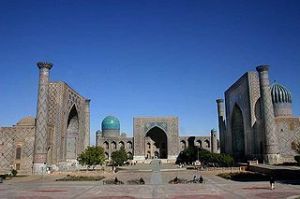
The Registan Mosque in Samarkand, Uzbekistan. Photo: Steve Evans (user babasteve on Flickr.com), CC BY 2.0 Generic License.
Sogdians were an ancient civilization of an Iranian people; there is material evidence that their religion was Zoroastrianism, which remained until after the Islamic conquest, when there was gradual conversion to Islam. Not politically aligned, Sogdiana’s various territories centered around Samarkand. They wrote in a variety of scripts, all derived from the Aramaic alphabet. Their unique clothing style was eventually Islamized.
- Most merchants did not travel the entire Silk Road but traded goods in a central oasis; the Sogdians established a trading network across the 1500 miles from Sogdiana to China, until they became the all-encompassing name for all merchants to trade with China’s Han Dynasty. Their relations flourished through 1st century BC. Sogdians played a major role in facilitating trade between China and Central Asia along the Silk Roads into the 10th century; their language became a lingua franca of trade, and in the 7th century the Buddhist pilgrim Xuanzang noted with approval that little boys were taught to read and write at the age of five, although their skill was turned to trade. It was also recorded that Sogdians worked as farmers, carpetweavers, glassmakers, and woodcarvers.
EXHIBIT SIGN:
REST STOP
After a long day’s journey along the Silk Road, weary travelers could stop to rest at a guesthouse or caravanserie. In Islamic lands these inns had a standard form: Rooms for sleeping and storing foods were arranged around an open courtyard where guests could water and feed their camels and horses. A thick wall with a guarded gate kept caravans secure. At a caravanserie, travelers of many cultures ate, bathed, traded goods, relaxed, and exchanged news.
WHAT WASN’T SAID:
[ezadsense midpost]
- That there were inns that provided sex workers to the Silk Road merchants; one Sogdian-language contract shows at least one Chinese bought a Sogdian girl in 639 AD. Earlier 7th century documents point to massive volume in the slave trade, with some recorded marriages. One record shows a Sogdian merchant sold an 11-year-old girl for 40 bolts of silk.
- That this may be an instance of the flourishing slave trade. As a youth, Mohammed accompanied his uncle on the caravan expeditions, dealing in human slavery and trading the items looted from the conquered peoples.
- That many cultures of weary travelers remain unidentified, although they contributed and are defined in history.
FACTS from IslamWatch:
- “Slavery is part of Islam; Slavery is part of jihad and will remain as long as there is Islam. (“Those who argue that slavery has been abolished are ignorant, not scholars. They are merely writers. Whoever says such things is an infidel.” – Sheikh Saleh al-Fawzan, member of Senior Council of Clerics, Saudi Arabia, 2003.
- “Besides being practiced more or less openly today in Sudan and Mauritania, there is evidence that slavery still continues beneath the surface in some majority-Muslim countries as well – notably Saudi Arabia, which only abolished slavery in 1962; Yemen and Oman, both of which ended legal slavery in 1970; and Niger, which officially banned slavery in 2004, but which ban is widely ignored, and as many as one million people remain in bondage. Slaves are bred, often raped, and generally treated like animals.” Dr. Daniel Pipes, New York Post (July 30, 2002)
- “…the worst, most inhumane and most diabolical institution of the black African slave trade was initiated, refined, perpetrated and implemented by the Mohammedan Arabs and later aided and abetted by the black converts to Mohammedan Islam.” – Robert Spencer, “The Persistence of Islamic Slavery.”
EXHIBIT SIGN:
The Sogdian merchants of Samarkand were masters of trade along the Silk Road. Some put up the money for long-distance exchange. Some haggled in markets. And some acted as camel drivers and caravan leaders. A single caravan might include peddlers, pilgrims, soldiers, guides and many horses, mules and camels. The leader had to show skill at handling both animals and people, as well as courage and knowledge of the trail.
WHAT WASN’T SAID:
- That the Sogdian designation for merchants of Samarkand remain unexplained; the exhibit continues its focus on Arabs.
- That skill may have been needed to handle animals and people, named in a questionable order, unless the people are women and children who had been abducted into slavery.
FACTS:
- The Silk Road exhibit is a tribute to the Islamic culture, although all negative characteristics have been whitewashed, removed, and replaced with positive traits that were usurped from the cultures conquered by Islam. Islam was and continues to be a culture of conquest, subjugation, and genocide, and history shows that it is responsible for the killing of 270 million people over 1400 years; hence, no major changes.
- The contributors of the Middle Eastern lands that were once not Islamic and not all Arabic are combined to assume about 80% of the attribution, giving China the remaining 20%. However, research paints another picture entirely. The countries involved in the Silk Route include China, Persian Empire, Greece (particularly maritime trade routes), and mainland Europeans; by religion, they include Jews, Zoroastrians, Buddhists, Romans, Grecians, Hindus, Pharaohans, Christian sects and Muslim..
- Dating back about three millennia, the Jewish community in Iran is the oldest in Asia. They were freed from slavery by Persia’s Emperor Cyrus in 539 BCE and became an integral part of the Persian Empire. As such, they travelled widely in Persian-dominated Afghanistan, the Caucasus and Caspian through Central Asia. They traded with displaced Turgik tribes, and Khazars (glassworks factories, c. 7th and 8th centuries). Persian Jews were merchants in Uzbekistan, Central Asian Silk Road in Bukhara and Samarkand , where major trading posts were established.
[ezadsense leadout]
(to be continued)
Author of “Confronting the Deception,” Tabitha Korol began her political career after 9/11, with letters to the editor and essays, developing a readership and earning two writing awards along the way. Her work appeared on Academia.edu, Christian Action Network, Conservative News and Views, Dr. Rich Swier, iPatriot, Liberty News & Views, LobbyistsforCitizens.com; Published Reporter, Renew America, Ted Belman, The Noisy Room, Trevor Loudon’s New Zeal, Virginia Christian Alliance, WebCommentary, and others.
-

 Civilization3 days ago
Civilization3 days agoDC Pipe Bomb Arrest Raises Questions About Christopher’s Wray’s FBI
-

 Civilization4 days ago
Civilization4 days agoThe Legal Logic Behind U.S. Operations Against Narco-Terrorist Networks
-

 Executive4 days ago
Executive4 days agoNewsom’s ‘National Model’ for Homeless Wracked by Fraud
-

 Executive3 days ago
Executive3 days agoWhen You’re in a Hole, Stop Digging
-

 Education3 days ago
Education3 days agoWaste of the Day: Taxpayers Subsidize Football Coach Severance
-

 Executive2 days ago
Executive2 days agoWaste of the Day: Obamacare Failed Test, Approved Fraudulent Subsidies
-

 Civilization2 days ago
Civilization2 days agoPence Calls on Trump To Fire RFK Jr Over Abortion Drug
-

 Executive4 days ago
Executive4 days agoWaste of the Day: Feds Pay Nonprofits That Sue the Government







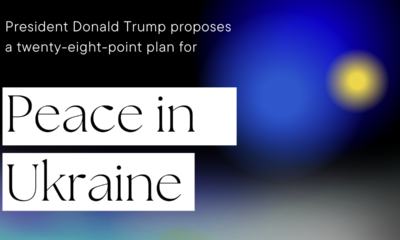

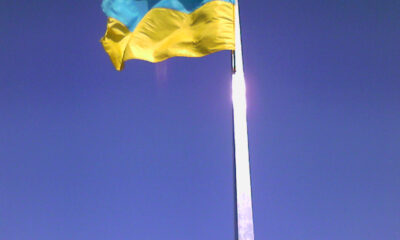

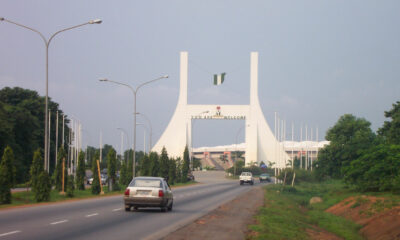



Jim Levandowski liked this on Facebook.
[…] Silk Road notes 2: trade […]
[…] Silk Road notes 2: trade […]
[…] Silk Road notes 2: trade […]
[…] Silk Road notes 2: trade […]
[…] BRI is China’s version of the ancient Silk Road where camel caravans carried silk from China to Europe and the Middle East. It also reminds me of […]